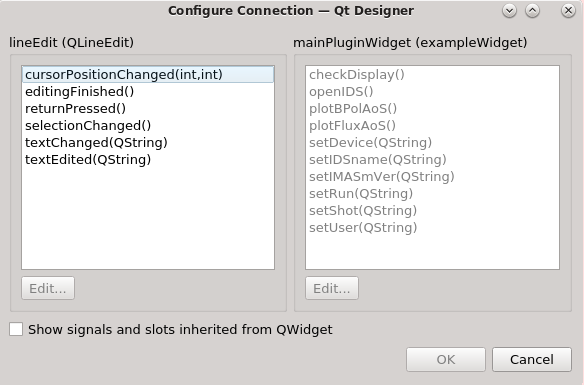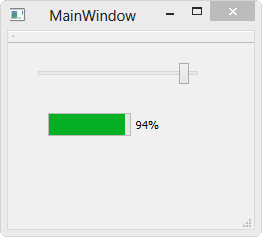Qt Connect Signal Parent Slot
Qt connects widgets by means of a nice designed scheme based on the idea that objectS may send signalS of different typeS to a single object instance: This is a screenshot of the example code running. The main application creates dialogs A and B and then connects the signal from A to the signal slot in B. QPushButton emits signals if an event occurs. To handle the button connect its appropriate signal to a slot: connect(mbutton, &QPushButton::released, this, &MainWindow::handleButton); Example. The following simple code snippet shows how to create and use QPushButton. It has been tested on Qt Symbian Simulator. An instance of QPushButton is. While being better in many regards, the new connection syntax in Qt5 has one big weakness: Connecting overloaded signals and slots. In order to let the compiler resolve the overloads we need to use staticcasts to member function pointers, or (starting in Qt 5.7) qOverload and friends. Qt Connect Signal To Parent Slot, poker night at the inventory g2a, trucchi per vincere roulette francese, gambling permit.
EnArBgDeElEsFaFiFrHiHuItJaKnKoMsNlPlPtRuSqThTrUkZh
This page was used to describe the new signal and slot syntax during its development. The feature is now released with Qt 5.
- Differences between String-Based and Functor-Based Connections (Official documentation)
- Introduction (Woboq blog)
- Implementation Details (Woboq blog)
Note: This is in addition to the old string-based syntax which remains valid.
- 1Connecting in Qt 5
- 2Disconnecting in Qt 5
- 4Error reporting
- 5Open questions
Connecting in Qt 5
There are several ways to connect a signal in Qt 5.
Old syntax
Qt 5 continues to support the old string-based syntax for connecting signals and slots defined in a QObject or any class that inherits from QObject (including QWidget)
New: connecting to QObject member

Here's Qt 5's new way to connect two QObjects and pass non-string objects:
Pros
- Compile time check of the existence of the signals and slot, of the types, or if the Q_OBJECT is missing.
- Argument can be by typedefs or with different namespace specifier, and it works.
- Possibility to automatically cast the types if there is implicit conversion (e.g. from QString to QVariant)
- It is possible to connect to any member function of QObject, not only slots.
Cons
- More complicated syntax? (you need to specify the type of your object)
- Very complicated syntax in cases of overloads? (see below)
- Default arguments in slot is not supported anymore.
New: connecting to simple function
The new syntax can even connect to functions, not just QObjects:
Pros
- Can be used with std::bind:

- Can be used with C++11 lambda expressions:
Cons
- There is no automatic disconnection when the 'receiver' is destroyed because it's a functor with no QObject. However, since 5.2 there is an overload which adds a 'context object'. When that object is destroyed, the connection is broken (the context is also used for the thread affinity: the lambda will be called in the thread of the event loop of the object used as context).
Disconnecting in Qt 5
As you might expect, there are some changes in how connections can be terminated in Qt 5, too.

Old way
You can disconnect in the old way (using SIGNAL, SLOT) but only if
- You connected using the old way, or
- If you want to disconnect all the slots from a given signal using wild card character
Symetric to the function pointer one
Only works if you connected with the symmetric call, with function pointers (Or you can also use 0 for wild card)In particular, does not work with static function, functors or lambda functions.
New way using QMetaObject::Connection
Works in all cases, including lambda functions or functors.
Asynchronous made easier
With C++11 it is possible to keep the code inline
Here's a QDialog without re-entering the eventloop, and keeping the code where it belongs:
Another example using QHttpServer : http://pastebin.com/pfbTMqUm
Error reporting
Tested with GCC.
Fortunately, IDEs like Qt Creator simplifies the function naming
Missing Q_OBJECT in class definition
Type mismatch
Open questions
Default arguments in slot
If you have code like this:
The old method allows you to connect that slot to a signal that does not have arguments.But I cannot know with template code if a function has default arguments or not.So this feature is disabled.
There was an implementation that falls back to the old method if there are more arguments in the slot than in the signal.This however is quite inconsistent, since the old method does not perform type-checking or type conversion. It was removed from the patch that has been merged.
Overload
As you might see in the example above, connecting to QAbstractSocket::error is not really beautiful since error has an overload, and taking the address of an overloaded function requires explicit casting, e.g. a connection that previously was made as follows:
connect(mySpinBox, SIGNAL(valueChanged(int)), mySlider, SLOT(setValue(int));
cannot be simply converted to:
...because QSpinBox has two signals named valueChanged() with different arguments. Instead, the new code needs to be:
Unfortunately, using an explicit cast here allows several types of errors to slip past the compiler. Adding a temporary variable assignment preserves these compile-time checks:
Some macro could help (with C++11 or typeof extensions). A template based solution was introduced in Qt 5.7: qOverload
The best thing is probably to recommend not to overload signals or slots …
… but we have been adding overloads in past minor releases of Qt because taking the address of a function was not a use case we support. But now this would be impossible without breaking the source compatibility.
Qt Connect Signal Parent Slot Machine
Disconnect
Should QMetaObject::Connection have a disconnect() function?
The other problem is that there is no automatic disconnection for some object in the closure if we use the syntax that takes a closure.One could add a list of objects in the disconnection, or a new function like QMetaObject::Connection::require
Callbacks
Function such as QHostInfo::lookupHost or QTimer::singleShot or QFileDialog::open take a QObject receiver and char* slot.This does not work for the new method.If one wants to do callback C++ way, one should use std::functionBut we cannot use STL types in our ABI, so a QFunction should be done to copy std::function.In any case, this is irrelevant for QObject connections.
EnArBgDeElEsFaFiFrHiHuItJaKnKoMsNlPlPtRuSqThTrUkZh
- 2Signals
- 3Basic Usage
- 4Example
Overview
Using QPushButton developers can create and handle buttons. This class is easy to use and customize so it is among the most useful classes in Qt. In general the button displays text but an icon can also be displayed.
QPushButton inherits QAbstractButton which in turn inherits QWidget.

Signals
Inherited from QAbstractButton
- void clicked(bool checked = false)
- void pressed()
- void released()
- void toggled(bool checked)
Inherited from QWidget
- void customContextMenuRequested(const QPoint &pos)
Inherited from QObject
- void destroyed(QObject *obj = nullptr)
Basic Usage
Text
Qt Connect Parent Signal To Child Slot

The text of QPushButton can be set upon creation or using setText(). To get the current text of the button use text().
Icon
The icon of QPushButton can also be set upon creation. After creation the icon can be changed using setIcon() To get the current icon of the button use icon()
Set Position and Size
To set the position and the size of the button use setGeometry(). If you want just to modify the size of the button use resize()
Handle Button
QPushButton emits signals if an event occurs. To handle the button connect its appropriate signal to a slot:
connect(m_button, &QPushButton::released, this, &MainWindow::handleButton);
Example
The following simple code snippet shows how to create and use QPushButton. It has been tested on Qt Symbian Simulator.
An instance of QPushButton is created. Signal released() is connected to slot handleButton() which changes the text and the size of the button.
To build and run the example:
- Create an empty folder
- Create a file for each of the below code snippets and add the example code to them (the name of the file should match the name above the snippet).
- All 4 files must be in the same folder.
- Using command line, navigate into the folder with the 4 files.
- run qmake on the project file:
qmake PushButtonExample.pro- If successful it will not print any output.
- This should create a file with the name Makefile in the folder.
- Build the application:
make- The application should compile without any issues.
- Run the application:
./PushButtonExample
The above steps are for linux but can easily be followed on other systems by replacing make with the correct make call for the system.